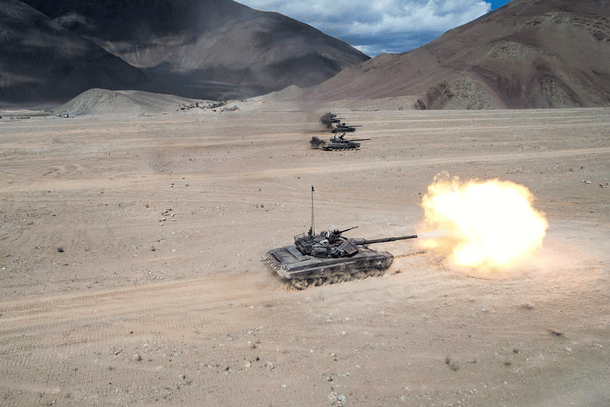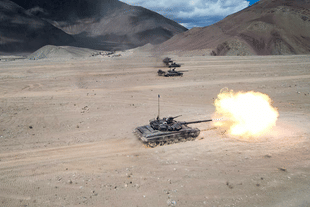Defence
In Pictures: Army Tanks, Helicopters Conduct Live Fire Exercise In Ladakh At An Altitude Of Over 15,000 Feet
Swarajya Staff
Sep 03, 2021, 03:14 PM | Updated 04:00 PM IST
Save & read from anywhere!
Bookmark stories for easy access on any device or the Swarajya app.


Indian Army tanks, armoured personnel carriers and helicopters participated in a live fire exercise on Thursday (3 September) in Ladakh.
The exercise, which involved integrated maneuvers, was conducted to check the operational preparedness of the Snow Leopard Brigade.
Although the Army did not reveal exactly where the exercise was held, it is likely to have taken place in eastern Ladakh. A report in the Indian Express says the exercise took place at an altitude of more than 15,000 feet.
Lieutenant General Y K Joshi, General Officer Commanding, Fire and Fury Corps, reviewed the preparedness of the units.
After the standoff with China in eastern Ladakh began last year, tanks and armoured personnel carriers were airlifted to the region using the US-built C-17 and Soviet-origin Il-76 heavy-lift transport aircraft.
While mechanised warfare has traditionally been associated with the plains, there are regions in Ladakh, mostly in its eastern part, where such forces can be deployed and the firepower that they bring to bear exploited.
In the event of a war, tanks will be used to defend the flat top approaches, from Tibet towards Leh, such as those near Chushul and Demchok. The flat terrain in this region, strategists say, allows the use of mechanised forces.
Over the years, China has built a network of motorable roads in the region, which in turn is linked to the G219 Highway (connecting Lhatse and Xinjiang) passing through occupied Aksai Chin, making it easier for the People’s Liberation Army to patrol the region and pour in troops from the mainland.
‘With tanks, we can cross the Demchok funnel (where Indus enters India) and intercept the highway in case of hostilities,’ Major General (retd) Sheru Thapliyal, former commander of the Ladakh-based 3rd Infantry Division, said in 2016.
While few know that there are areas in Ladakh where tanks can move, even fewer know that India has used tanks against China in the region.
During the 1962 war with China, the IAF had airlifted tanks to Chushul in south-eastern Ladakh right under the nose of the enemy. Antonov An-12 transport aircraft of IAF’s 44 Squadron, inducted just months ago in 1961, had moved six AMX-13 tanks of the 20 Lancers to Chushul.
In his book The Crimson Chinar: A Politico Military Perspective, Brigadier Amar Cheema notes that the tanks accomplished their task of deterring the enemy.
“The artillery, armour, services, and the Air Force can all be proud of the Battle of Chushul, and it can be counted as one of the most fiercely fought battle of the war, and one where Indians, working in synergy blunted the Chinese attack successfully,” Cheema writes, adding that the “armour acted as a tonic in more ways than plugging the Spanggur Gap. Tanks gave the men hope”.
In 2020, India had deployed tanks at the Kailash Range during the standoff with China in the area. Latest satellite images show Indian and Chinese tanks were positioned less than 500 feet apart at Rezang La, one of the peaks occupied by the Indian forces to preempt China.
In the 1990s, the IAF had airlifted 30 T-72 tanks from Agra to Leh for deployment in eastern Ladakh. In the 1990s, however, local army commanders thought the tanks were of little use. They were dismantled and moved out using Il-76 aircraft of the IAF’s 25 Squadron. This was reversed in 2014, when dozens of tanks were airlifted to Ladakh from Chandigarh onboard C-17s of the IAF.





